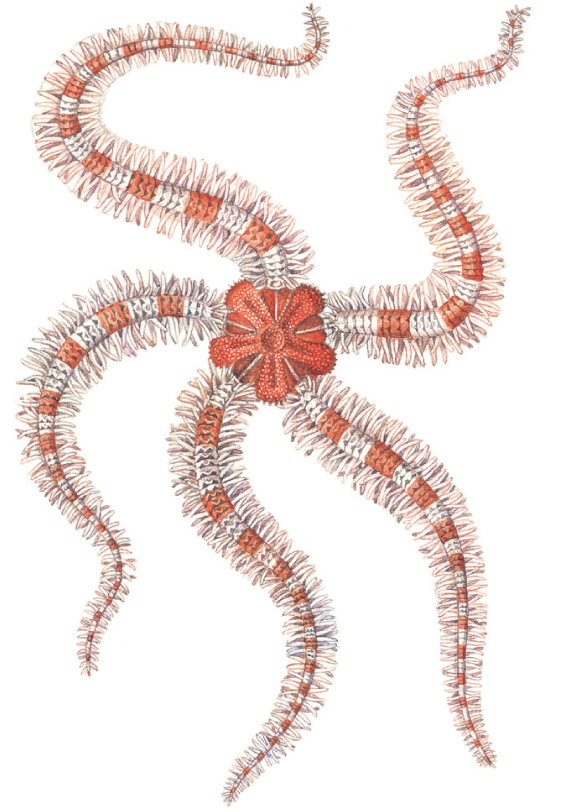
Common Starfish
Asterias rubens

SIZE AND DESCRIPTION
Length to 15cm; rarely larger, to 50cm. Five-pointed star-like animal that varies widely in size according to its age and situation. It has five regular arms, or points, which turn up at the ends when active, and is reddish, pink or orange above, paler below. Upper surface is covered by numerous small spines and tubercules. Several other species occur.
HABITAT AND ECOLOGY
Common and widespread on lower shores, among rocks, in shellfish beds or among algae, down to deep water.
DISTRIBUTION
Found in the Atlantic, English Channel, North Sea and western Baltic.
Spiny Starfish
Marthasterias glacialis

SIZE AND DESCRIPTION
Length to 30cm; to 75cm in deeper water. Animal with the typical starfish shape, but covered all over the upper surface with large spines. Usually greenish, or yellowish to reddish, pale and well camouflaged. There are five arms, which taper gradually towards the ends; these may break off if the animal is picked up.
HABITAT AND ECOLOGY
Moderately common, although rarely abundant, on lower shores, particularly where it is rocky or stony.
DISTRIBUTION
Occurs in the Atlantic, western part of the English Channel, North Sea and Mediterranean.
Feather Star
Antedon bifida

SIZE AND DESCRIPTION
Length to 15cm (arm). Plant-like animal consisting of a small disc with five pairs of long and feathery arms. Disc attaches temporarily to stones and rocks, and the arms wave about in the water. Colour is usually some shade of red, pink or purple, occasionally yellowish, and the arms may be striped.
HABITAT AND ECOLOGY
Widespread but very local from the extreme lowest shore downwards, among rocks and stones.
DISTRIBUTION
Occurs in the Atlantic, English Channel and northern part of North Sea.
Common Brittle Star
Ophiothrix fragilis

SIZE AND DESCRIPTION
Length to 10cm (arm). One of a distinctive group of animals consisting of a tiny central disc, about 2cm in diameter, with five long radiating arms. Colour is very variable, but usually bright red, purple, orange or violet, often strongly patterned or striped on the upper surface. Very fragile. One of the most common of the group, members of which are difficult to distinguish from each other.
HABITAT AND ECOLOGY
Common and widespread on the lower shore and into deep water, among stones, rocks and algae.
DISTRIBUTION
Occurs across the Atlantic, English Channel, North Sea and Mediterranean.
Edible Sea-urchin
Echinus esculentus

SIZE AND DESCRIPTION
Diameter to 10cm; may reach 17cm. Familiar animal both in its fully spined living form, and as a spineless empty ‘test’, or shell-like case. The test is an almost spherical ball that is slightly flattened at each ‘pole’. Spines are reddish-pink, and often tipped with purple. Test itself is red, orange or purple, with white scars from spines clearly visible. Several other species.
HABITAT AND ECOLOGY
Common and widespread, particularly in early summer, from the extreme lower shore down to deep water, among rocks, stones and algae.
DISTRIBUTION
Occurs in the Atlantic, English Channel and North Sea.